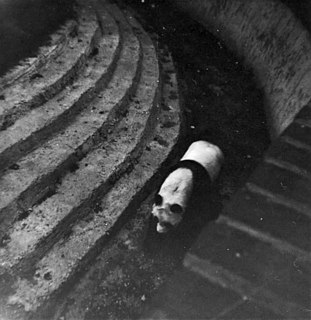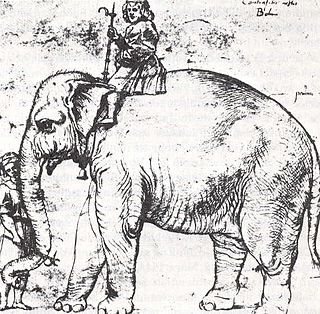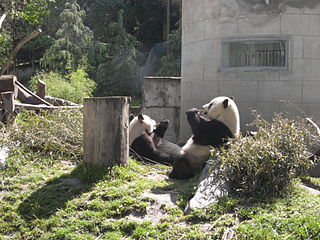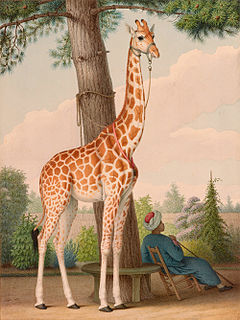 W
WAbada (or Bada or Ibada, was the name given to a female Indian rhinoceros kept by the Portuguese kings Sebastian I and Henry I from 1577 to 1580 and by Philip II of Spain from about 1580 to 1588. She was the first rhinoceros seen in Europe since the one sent as a present from the King of Portugal, Manuel I, to Pope Leo X in 1515, who died in a shipwreck off the coast of Italy in early 1516, immortalised as Dürer's Rhinoceros.
 W
WAbul-Abbas was an Asian elephant brought back to Carolingian emperor Charlemagne by his diplomat Isaac the Jew. The gift was from the Abbasid caliph Harun al-Rashid and symbolizes the beginning of Abbasid–Carolingian relations. The elephant's name and events from his life are recorded in the Carolingian Annales regni Francorum, and he is mentioned in Einhard's Vita Karoli Magni. However, no references to the gift or to interactions with Charlemagne have been found in Abbasid records.
 W
WAswan (1958–1984), originally named Raafat in Egypt. Aswan was a highly influential grey Egyptian-bred Arabian stallion who stood at the Tersk Stud in Russia. Sired by Nazeer out of Yosreia, he was given as a gift to the Soviet Union by the Egyptian government in 1963, in return for Soviet help in building the Aswan Dam.
 W
WBurmese (1962–1990), a black RCMP Police Service Horse (PSH) mare, was given to Queen Elizabeth II by the Royal Canadian Mounted Police and ridden by the Queen for Trooping the Colour for eighteen consecutive years from 1969 to 1986. She was trained and presented by RCMP Staff Sergeant Fred Rasmussen in 1969.
 W
WChi Chi was a well-known female giant panda at London Zoo in England.
 W
WThe Cremona elephant was a gift presented to Holy Roman Emperor Frederick II by Sultan of Egypt Al-Kamil, in 1229. Frederick used the elephant in his triumph parades.
 W
WDürer's Rhinoceros is the name commonly given to a woodcut executed by German painter and printmaker Albrecht Dürer in 1515. The image is based on a written description and brief sketch by an unknown artist of an Indian rhinoceros that had arrived in Lisbon in 1515. Dürer never saw the actual rhinoceros, which was the first living example seen in Europe since Roman times. In late 1515, the King of Portugal, Manuel I, sent the animal as a gift for Pope Leo X, but it died in a shipwreck off the coast of Italy in early 1516. A live rhinoceros was not seen again in Europe until a second specimen, named Abada, arrived from India at the court of Sebastian of Portugal in 1577, being later inherited by Philip II of Spain around 1580.
 W
WThe Godolphin Arabian, also known as the Godolphin Barb, was an Arabian horse who was one of three stallions that founded the modern Thoroughbred. He was named after his best-known owner, Francis Godolphin, 2nd Earl of Godolphin.
 W
WHanno was the pet white elephant given by King Manuel I of Portugal to Pope Leo X at his coronation. Hanno, an Asian elephant, came to Rome in 1514 with the Portuguese ambassador Tristão da Cunha and quickly became the Pope's favorite animal. Hanno died two years later from complications of a treatment for constipation with gold-enriched laxative.
 W
WLing Ling was a male Chinese-born giant panda who resided at the Ueno Zoo, the largest zoo in Tokyo, Japan. At the time of his death at the age of 22, Ling Ling was the only giant panda at the Ueno Zoo and the oldest panda in Japan. He served as an important symbol of the Ueno Zoo and of friendship between Japan and China. Ling Ling, who was given to Japan in 1992, was the only giant panda in the country who was directly owned by Japan. There are eight other giant pandas in Japan as of April 2008, but they are all on loan to Japan from China. Despite being a male panda, Ling Ling's name meant "darling little girl" in Chinese.
 W
WLing-Ling and Hsing-Hsing were two giant pandas given to the United States as gifts by the government of China following President Richard Nixon's visit in 1972. As a gift, the U.S. government sent China a pair of musk oxen.
 W
WThe Medici giraffe was a giraffe presented to Lorenzo de' Medici in 1487 possibly by al-Ashraf Qaitbay, the Burji Sultan of Egypt, in an attempt to win the support of the Medici.
 W
WPanda diplomacy is a term used to describe China's practice of sending giant pandas to other countries as a symbol of diplomatic goodwill.
 W
WUnited States presidents have often kept pets while in office, or pets have been part of their families. Donald Trump is the first president since James K. Polk to not have a presidential pet while in office.
 W
WThe Rhinoceros of Versailles was a living Indian rhinoceros which was kept in the Palace of Versailles menagerie from 1770 until 1793.
 W
WSaturn was an American alligator residing in the Moscow Zoo. He was the subject of an urban myth that he was previously Adolf Hitler's "pet alligator".
 W
WSuleiman was an Asian elephant that was presented to the Habsburg Archduke Maximilian II by King John III of Portugal and his wife, Catherine of Austria, Habsburg princess and youngest sister of the Emperor Charles V.
 W
WTuan Tuan and Yuan Yuan are two giant pandas that were sent by mainland China to Taiwan in 2008 as part of an exchange program. The exchange idea was first proposed in 2005, but the previous administration in Taiwan had refused to accept the pandas. After elections that resulted in a change of presidents in 2008, Taipei accepted the pandas, and they arrived in Taiwan on December 23, 2008. The two names were selected by a vote in the PRC and their combination, Tuan Yuan, means "reunion" in Chinese. The pandas are being housed at Taipei Zoo and have been exhibited to the public since the 2009 Chinese New Year.
 W
WYuan Zai is a female giant panda born at the Taipei Zoo on July 6, 2013. She is the first panda cub born in Taiwan, to parents Tuan Tuan and Yuan Yuan by artificial insemination. As Tuan Tuan and Yuan Yuan were sent to Taiwan from People's Republic of China in exchange for two Formosan sika deer and two Taiwan serows, Yuan Zai does not need to be returned.
 W
WZarafa was a female Nubian giraffe who lived in the Jardin des Plantes in Paris for 18 years. A gift from Muhammad Ali of Egypt to King Charles X of France, she was one of three giraffes Muhammad Ali sent to European rulers in 1827. These were the first giraffes to be seen in Europe for over three centuries, since the Medici giraffe was sent to Lorenzo de' Medici in Florence in 1486. She didn't receive the name "Zarafa" until 1985.